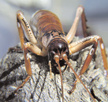Looking At New Zealand
Where in the World Is New Zealand?, What Is the Geography of New Zealand?
Where in the World Is New Zealand?
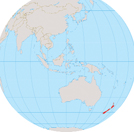
New Zealand is an island nation in the southern hemisphere. It is in the southwest Pacific Ocean. Look at the world map in the Atlas on pages 202-203. Notice that New Zealand is one of the last countries before you reach Antarctica. (Chile and Argentina in South America are the other countries.) Because of the oceans, however, the country has a mild and pleasant climate. New Zealand is about the size of Colorado.
Two large islands make up the country of New Zealand. They are called North Island and South Island. There are also many smaller islands. Most of the population lives on North Island. In the center of the island, there is a large flat plateau. Many sheep and cattle ranches are here. Farmers grow fruits and vegetables along the coastal area. The island also has three active volcanoes.
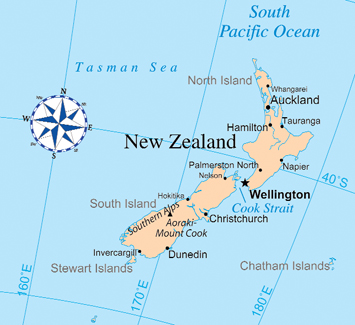 New Zealand: Political Map
New Zealand: Political Map
On the map, find Cook Strait. A strait is a narrow body of water between two pieces of land. This narrow passage separates the two islands. It takes three hours by ferry to cross the strait. There is a beautiful chain of mountains on South Island. It is called the Southern Alps. They are 300 miles (482 km) long and run along the west coast. The highest mountain is called Aoraki-Mount Cook.
There are glaciers (glay-shurs) along the mountain sides. Glaciers are slow-moving sheets of ice. These glaciers are high up in the mountains. Some glaciers are thousands of feet thick. As they move down the mountain, their weight cuts deep valleys at the base of mountains.
Along the southwest coast, there are long valleys flooded by the ocean. High mountains drop down into the water. These steep valleys are called fjords (fyords). A fjord is a valley with steep sides. Glaciers cut these deep fjords. The sea filled them with water.
New Zealand's nearest neighbor is Australia. But that country is 1,250 miles (2,011 km) away. Unlike Australia, New Zealand is very mountainous. The climate has mild temperatures and plenty of rainfall throughout the year. The total land area is 103,738 square miles (268,681 sq km). The islands stretch out north and south about 1,000 miles (1,609 km.) The area is a little smaller than another island nation you studied in Unit 3: Japan.
The land in New Zealand is so beautiful that the country is a popular place to make movies. The Lord of the Rings was filmed in New Zealand.
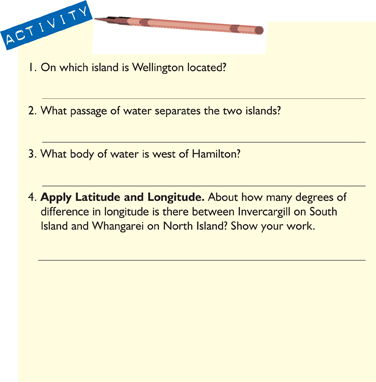
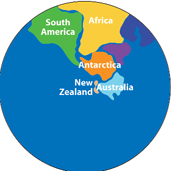 Gondwana 140 Million Years Ago
Gondwana 140 Million Years Ago
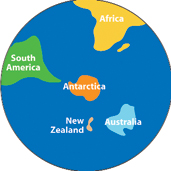 New Zealand Today
New Zealand Today
What Is the Geography of New Zealand?
New Zealand is full of amazing sights. On South Island, there are hiking trails near mountains, glaciers, and fjords. Steaming volcanoes erupt on North Island. Near Lake Taupo and Rotorua, hot rocks lie close to the earth's surface. These rocks heat the ground water. When the water boils to the surface, it makes geysers (gye-zurz) and hot springs. Geysers occur when this hot water and steam shoots out high into the air.
In New Zealand, there are rivers, clear blue lakes, and beautiful coastlines everywhere. After all, the native people call New Zealand the “land of the long white cloud.” Where did all this beauty come from?
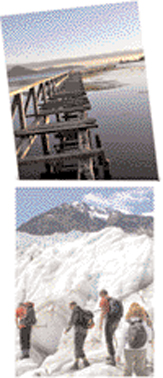 Sunrise on Lake Taupo in New Zealand
Sunrise on Lake Taupo in New Zealand
Hikers on Franz Joseph glacier
Two hundred million years ago, New Zealand was a part of a large continent. Remember the large landmass called Pangaea (see page 30). Part of the landmass in the southern hemisphere is called Gondwana (gon-dwah-nah). The movement of huge plates under the earth's surface made Gondwana split apart. Look at the maps to see how different pieces became the continents and countries that we know today.
The sea separated New Zealand from other land areas. The birds, animals, and plants on the islands did not change over time. There were no mammals. The only mammals to reach New Zealand were bats. Bats could fly. Insects, called wetas, grew as big as mice. The kiwi bird did not have any natural enemies. So it never learned to fly. Giant snails and worms still live underground and in caves. Like native plants in Australia, the native plants of New Zealand do not grow anywhere else in the world.
Lizards, frogs, and bats are the only land animals native to New Zealand. About 1,000 years ago, the Maori (mow-ree) people landed their canoes in New Zealand. They brought dogs and rats.
When European settlers came in the 1800s, they brought deer, trout, salmon, opossum, and rabbits. The rabbits caused terrible problems. They destroyed many native plants. Today, New Zealand has laws against importing plants, fruits, and animals. By doing this, the Ministry of Agriculture and Fisheries protects the environment in New Zealand.
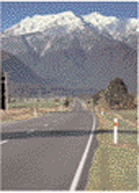 The Southern Alps
The Southern Alps
North Island is part of the Pacific Ocean “Ring of Fire.” Great forces under North Island push the earth's plates together. This force causes many volcanoes on the island. The volcano Ruapehu erupted in 1995. Today, sheep and cattle graze on the rich volcanic soil.
On South Island, the force of the two plates crashing into each other created the Southern Alps. The Canterbury Plains are on the east coast of the island. They form New Zealand's largest area of flat land. Farmers grow grains and ranchers raise sheep here.
 Elevation Map of South Island
Elevation Map of South Island
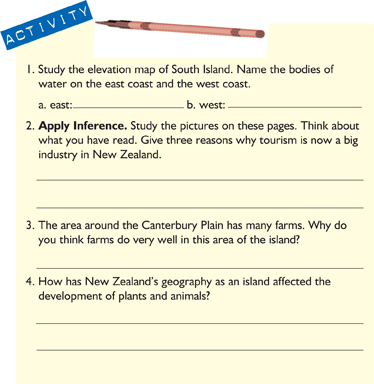
What Is the Climate Like in New Zealand?
Are you surprised to learn that New Zealand is about half way between the equator and the South Pole? But the climate is not very cold. The ocean currents make the climate mostly mild or temperate. “The land of the long white clouds” enjoys very sunny weather. There are many hours of sunshine a day and plenty of sunshine during winter months. This makes playing at the beach a lot of fun.
Because Australia and New Zealand are below the equator, the seasons are the opposite of the seasons in North America. Summer is from December to February. Fall is from March to May. When you and your friends are on summer vacation from June to August, the children in New Zealand are having winter.
The average temperature in New Zealand drops as you travel south. The north of New Zealand has a more tropical climate—warm and humid. The warmest months are December, January, and February. The coldest months are June, July, and August. In summer, the average maximum temperature ranges from 68° F to 86° F, and in winter the temperature ranges from 50° F to 59° F.
The west coast of South Island has heavy rainfall all year. The rain keeps the rain forests thick and green. Look at the map on page 180. Bananas and other tropical fruits grow north of Auckland on North Island. The climate is more tropical and the weather is warm and humid. On South Island, the weather below Christchurch is cooler. This is the first area to feel the icy winds from Antarctica.
New Zealand gets a lot of rain. The average rainfall is between 25 and 59 inches. The rain is also spread evenly through the year. The mountains make a big difference in how much rain falls in a place. Find Dunedin on the map on page 180. The city receives about 12 inches (30 cm) of rain a year. But the Southern Alps have more than 315 inches (800 cm) of rain in a year. See the map on page 187 to locate the mountains.
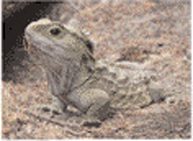 A tuatara
A tuatara
Kiwis, or New Zealanders, love to describe their weather as “four seasons in one day.” There may be frost in the morning and warm and sunny in the afternoon. The weather changes all the time. The climate of New Zealand is special. Alpine mountain ranges, tropical rain forests, and sunny beaches all happen in one small place!
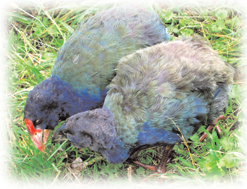 >Takahe bird
>Takahe bird
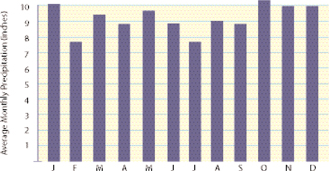 Annual Rainfall in Hokitika, West Coast, South Island
Annual Rainfall in Hokitika, West Coast, South Island
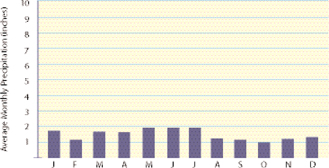 Annual Rainfall in Christchurch, East Coast, South Island
Annual Rainfall in Christchurch, East Coast, South Island
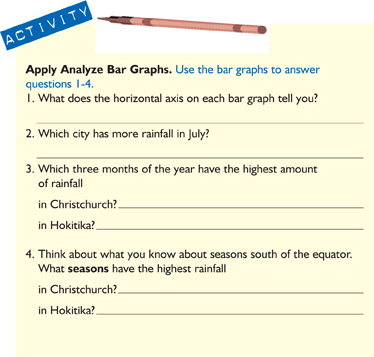
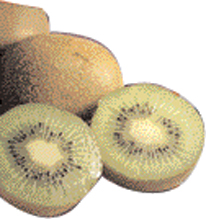 Kiwi fruit
Kiwi fruit
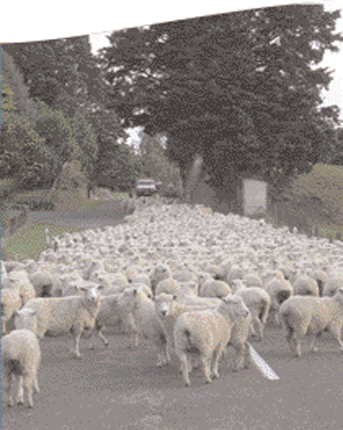 A sheep herd is crossing a road.
A sheep herd is crossing a road.
How Do New Zealanders Use the Land?
Do you ever wonder where some of the foods you like come from? Not all food products are from the United States. The fruit you had on your cereal this morning might be from Chile. Some fruits and vegetables, like tomatoes, even come from farms in Israel. Think about how far food must travel to reach your grocery store.
New Zealand is far away from markets in North America and Europe. Yet the country is one of the largest exporters of wool, dairy products, and lamb in the world. How can this be possible?
One-third of the land in New Zealand is used for grazing and crops. Because of the mountains, the land is not good for growing crops. But it is good for feeding animals. That is why New Zealand's 60 million sheep and 9 million cattle graze in this area.
Most New Zealand farmers use modern machinery and equipment to farm. This means they can harvest (collect) their crops much cheaper and faster than if they had to hire people to do the work. Because of the cheaper costs to harvest crops, farmers can charge less money when they sell their crops to supermarkets. Many New Zealand farms are run so well that they only need about 110,000 people to work on about 70,000 farms and orchards. That comes out to only about 1 1/2 people working full time per farm.
New Zealand's main natural resource is timber. In 1886, a volcano on the North Island erupted. It buried villages and spread thick dust and ash for miles. In the 1920s, the country began a program to plant trees. New Zealanders planted California Pine Trees. These trees produce soft wood. It grows well in the soil left by the volcano.
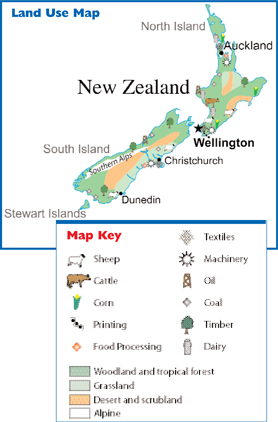
New Zealand is rich in volcanic activity. Geysers shoot hot water and steam into the air. This environment creates geothermal energy. Geothermal energy comes from heat deep in the earth's crust. The steam and hot water from geysers and volcanoes is used to produce energy. The geothermal energy is used to heat homes and businesses. Because of the volcanic activity in New Zealand, the country has a good supply of renewable energy. Renewable energy is energy that can be renewed, or made again, as it is used up. Examples of renewable energy are wind, water, and solar power. Fossil fuels, like oil, gas, and coal, are nonrenewable. Once fossil fuels are used up, the supply is gone.
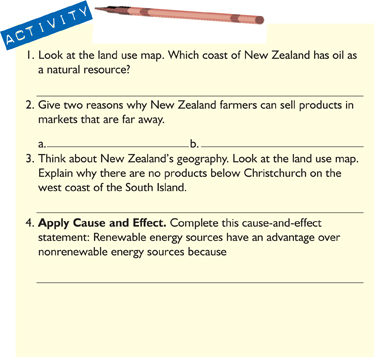
How Has History Shaped the People of New Zealand?
The Maori came to New Zealand over a thousand years ago. Family clans set out in large canoes from Polynesia. Each canoe carried all of the clan's goods, including dogs, hens, plant seeds, tools, and clothing.
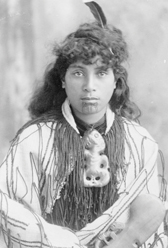 A Maori woman in traditional clothing
A Maori woman in traditional clothing
When the clans reached New Zealand, they spread out over the islands. Each group claimed a piece of the land. This became their tribal homeland.
The climate in New Zealand is colder than Polynesia. It was difficult to grow tropical crops, like coconuts, which the Maori brought with them. Maori men hunted ground birds, fish, and shellfish for food. They learned to adapt, or change, their ways of living. Women learned to use plant fibers to make warmer clothing.
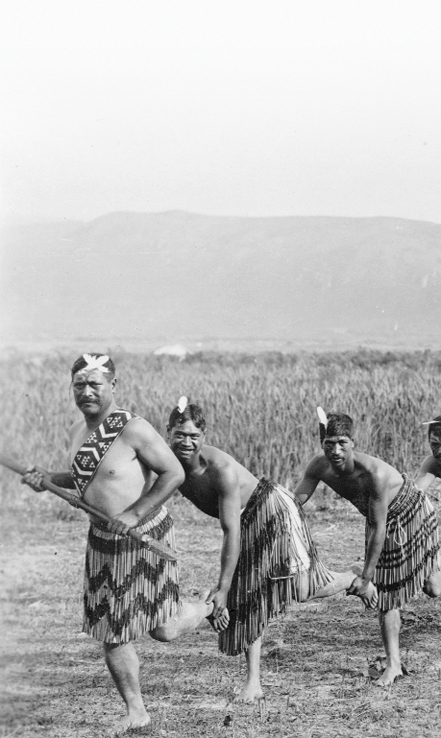 Maori men performing a war dance
Maori men performing a war dance
Maori men were fierce warriors. The warriors cut mokas, or sacred tattoos, into their faces and bodies. They used feathers and bones to decorate their clothing. The Maori did not have a written language. Each clan chose one person to remember their history through songs, sayings, and stories. The stories became oral traditions. Storytellers told these stories during special ceremonies. This is how the Maori remember their history.
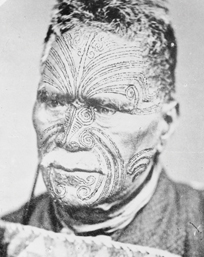 Maori King Tawaiho. Note the mokas, sacred tatoos, cut into his face.
Maori King Tawaiho. Note the mokas, sacred tatoos, cut into his face.
Because of their storytelling tradition, Maori are good speakers. They have special words and ceremonies to greet guests. When Maori people greet each other, they touch noses instead of shaking hands.
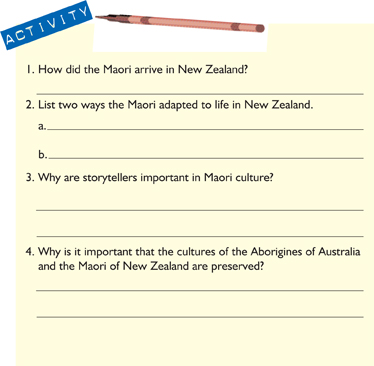
The food of the chief is talk.
This Maori saying means that when a chief says something, his honor depends on the truth of his words.
The Maori and the “Pakeha” (pah-keh-ah). The Maori use the word pakeha to mean anyone who is not a Maori.
In 1642, Abel Tasman, a Dutch explorer, discovered the islands of New Zealand. Fierce Maori warriors drove them away. Dutch geographers named the islands Nieuw Zeeland after the province of Zeeland in the Netherlands. French explorers also tried to settle on the islands. Once again, Maori warriors drove off the invaders.
In 1769, the British Captain James Cook arrived in New Zealand. Captain Cook explored the island three different times. He finally made peace with some of the Maori clans. On February 6, 1840, a treaty was signed between Maori chiefs and Britain. The Treaty of Waitangi made New Zealand a British colony. The Maori became British citizens. The treaty also guaranteed land for the Maori. But British settlers and the Maori people fought over land for many years.
The pakeha had a big effect on Maori culture. Christian missionaries brought Christianity to the people and an alphabet for the Maori language. The Maori learned English from the missionaries. British settlers brought pigs, sheep, and cattle. The animals became important for food and trade. The British also brought guns, gunpowder, and diseases.
Not everything the pakeha brought was helpful. The guns and gunpowder spread more wars among the Maori tribes. European diseases, like the flu, killed thousands of Maori. British settlers also brought rabbits. The rabbits munched their way through much of the plant life on the North Island. By 1900, only about 40,000 Maori were left in New Zealand.
Primary Sources
The Treaty of Waitangi, 1840
Article Two
Her Majesty the Queen of England confirms and guarantees to the Chiefs and Tribes of New Zealand and to the respective families and individuals … the full … possession of their Lands and Estates, Forests, Fisheries, and other properties, which they may … possess so long as it is their wish and desire to retain the same in their possession; but the Chiefs … yield to Her Majesty the exclusive right … over such lands … at such prices as may be agreed upon between the respective proprietors [owners] and persons appointed by Her Majesty to treat with them in that behalf.
What Is New Zealand Like Today?
In 1907, New Zealand became independent. The country joined the British Commonwealth of Nations, a group of fifty-three independent nations. They work on development and trade. Most of the nations were once British colonies. Queen Elizabeth II of England is the head of the Commonwealth. But she does not have any political power.
Like Australia, New Zealand is a parliamentary democracy. The people elect members to represent them in parliament, which chooses a prime minister to head the government. New Zealand has only one House of Representatives. They make laws for the country. In 2006, the Maori people received seven seats in Parliament. The seats give them representation in government. They vote to protect the rights of the Maori people and culture.
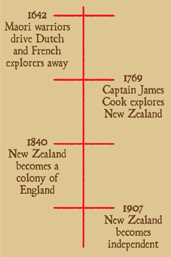
The Maori struggle to get back the land that was taken from them. They use the words of the Treaty of Waitangi and the courts to fight for their land. New Zealand courts have returned some of the land to them.
Young Maori want to keep their traditional culture. They also want to be a part of pakeha culture. They believe in the idea of maoritanga (mah-or-eh-tahn-gah), or the Maori way of doing things.
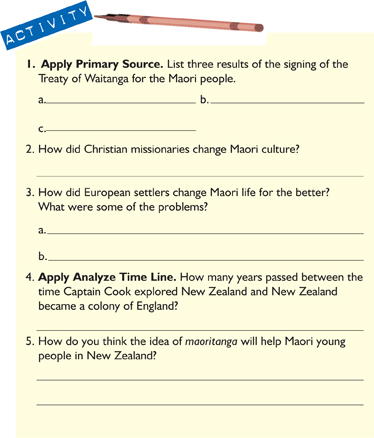
What Makes New Zealand So Special?
You have learned that the Maori settled New Zealand very recently—in terms of history. The country does not have a long history. There are no ancient castles or walled cities. There are only a few museums. Tourism, however, is an important industry. New Zealand has features that tourists love.
Imagine you are a tourist on a visit to New Zealand. The first thing you notice is the smell of clean, fresh air. The temperature feels so mild. You have read about New Zealand's unusual plants and animals. The four inch bug crawling near your foot must be the famous weta!
You have packed your favorite pair of hiking shoes. In Fiordland, the hikes are called “great walks.” You want to try the Milford Track. This hike takes five days to finish. However, you're not worried. The park has huts where visitors can camp overnight. Imagine seeing beautiful waterfalls tumbling along the sides of the fjords. At night, you will hear the call of the kiwi, New Zealand's national bird. During the day, you plan to swim and fish in the sky-blue lakes.
When you buy gifts to take home, you might look for things made from green jade. The region is an important source for this valuable mineral. The Maori call Fiordland Te Wahipounamu, "the place of green stone.” Their artists make jewelry and sacred objects from the jade.
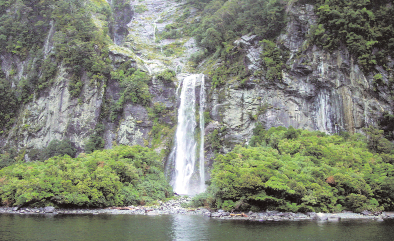 Milford Sound in Fiordland National Park
Milford Sound in Fiordland National Park
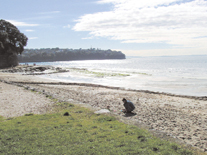 Mairangi Bay, East Coast Bays, Auckland, New Zealand
Mairangi Bay, East Coast Bays, Auckland, New Zealand
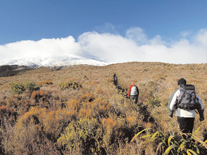 Tongariro Crossing, a hiking track in New Zealand
Tongariro Crossing, a hiking track in New Zealand
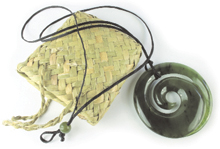 Carved Maori nephrite jade pendant, New Zealand
Carved Maori nephrite jade pendant, New Zealand
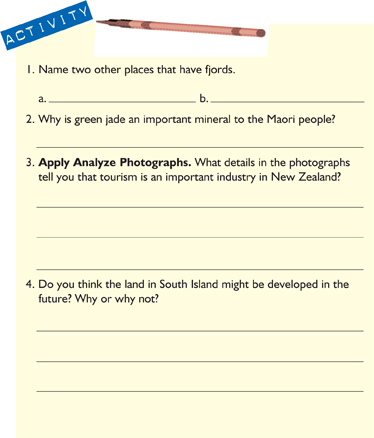
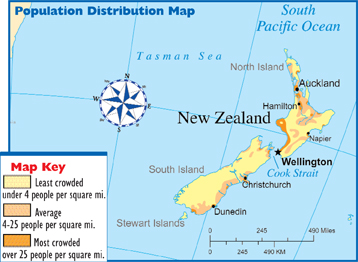
Where Do People Live in New Zealand?
Life on North Island. The largest cities are located on North Island. The climate is mild, and industry is more developed. New Zealand's main natural resource is timber. Thick forests on the North Island produce wood products for industry. Many people work in papermaking and printing plants.
New Zealand is not like other densely populated countries. There is not much pollution. Citizens and government groups guard the land, air, and water resources carefully. There are laws that protect plants and animals.
If you lived on North Island, there might be earthquakes. Students take part in earthquake drills in their classrooms. They practice crawling under their desks to keep safe from falling walls and ceilings.
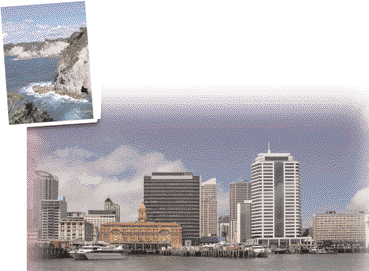 Bay of Plenty, North Island
Bay of Plenty, North Island
Auckland, New Zealand
Life on South Island. Christchurch is the biggest city on South Island. It has a population of over 320,000. It is often called the “Garden City.” The city has flower gardens everywhere. The Avon River winds through the city. The river is so clean that it is full of fish. Children under 12 years old can fish in the river for free.
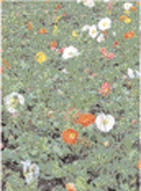 Shirley poppies color the public gardens in Christchurch, New Zealand.
Shirley poppies color the public gardens in Christchurch, New Zealand.
The people living on farm stations travel to Christchurch about once a week. Small markets line the National Highway into the city. People stop at the post office for mail and at the bank. After shopping for food and other goods, farmers stop at the wool store. Wool from sheep all over the island is gathered here. The wool is graded by quality.
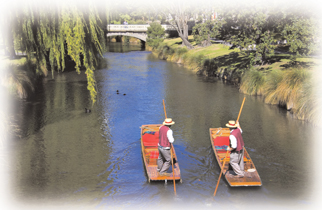 Enjoying the Avon River
Enjoying the Avon River
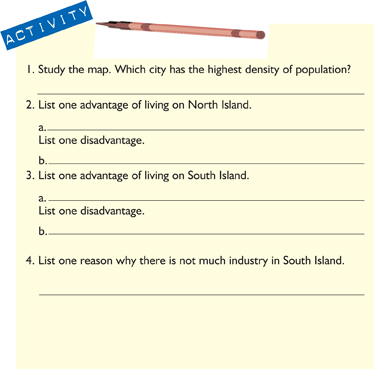
What Is Life Like on a Sheep Station?
Imagine that you take the ferry from Wellington to South Island. You travel south on National Route 1. As far as you can see, there are sheep grazing on hillsides. You are visiting Neil Stuart. Neil is eleven years old. He lives on a family station. That is what farms are called in New Zealand. His family has 2,000 sheep and 300 head of cattle. Their station has 375 acres of land.
In August, men come to shear the sheep. They shave, or cut off, the sheep's wool. This is the busiest time of year. The shearers work from sunrise to sunset. Each shearer can shear 200 sheep a day. Neil is busy too. He counts the sheep and helps sweep up the wool on the floor. His family sells the wool to people who turn it into fine woolen material. Many clothes are made of wool and wool blends.
In September, the lambs are born. Lambs are raised for several months. At the end of January, the lambs are sold. The family sells about 1,000 lambs a year. One important job on the station is to gather hay for the winter. A machine cuts, rolls, and places the hay in rows. Each bale, or roll, of hay weighs 500 pounds. Neil likes to jump on the tall bales of hay.
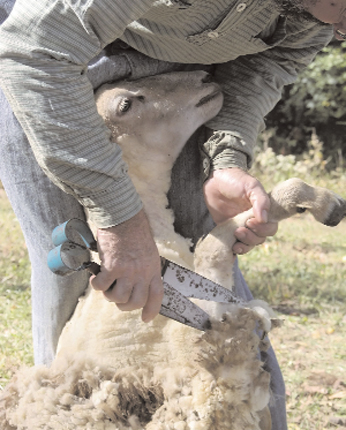 New Zealand is the largest exporter of sheep wool. Here a sheep is being sheared, or shaved, of its wool.
New Zealand is the largest exporter of sheep wool. Here a sheep is being sheared, or shaved, of its wool.
When there is rain or wind, Neil and his father must herd the sheep into the barn. They drive the sheep by shouting and clapping. Sometimes the sheep just do not pay attention. They move too slowly. Neil plans to have his own sheep station some day. When he does, he wants sheep dogs. Then he will whistle to the dogs, and they will drive the sheep.
Neil's family also raises beef cattle. Sometimes they move the cattle to new grazing land. The land is higher up the mountains. The cattle drive takes two hours. This is tiring work. Neil's mother arrives by truck with lunch for Neil and his father.
Where Are the Schools?
Most students live in cities or towns. They go to school from about 9:00 A.M. to 3:30 P.M. five days a week. But very few people live near Neil. It is an isolated area. There is no school. New Zealand has a special school called the State Correspondence School for children living far from cities or towns. They send lessons to Neil at home. He completes the work and sends it back to the teacher. Classes are given over the radio everyday. He takes an exam at the end of the school year. Sometimes, a teacher will visit his home. Several times a year, students get together for a “school week.” At school week, they get to work with other children. The students of the State Correspondence School have their own magazine and club activities.
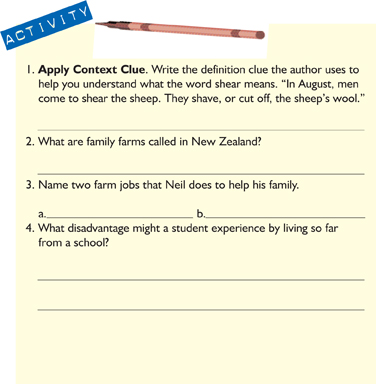
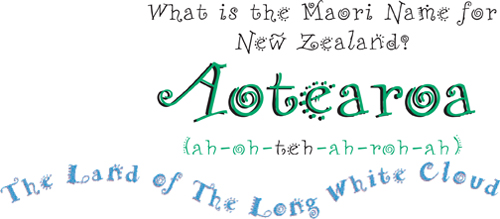
What Is Maori Culture Like in New Zealand?
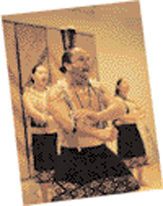 Maori cultural performance in Auckland
Maori cultural performance in Auckland
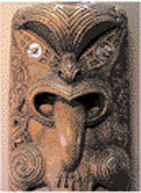 Maori carving
Maori carving
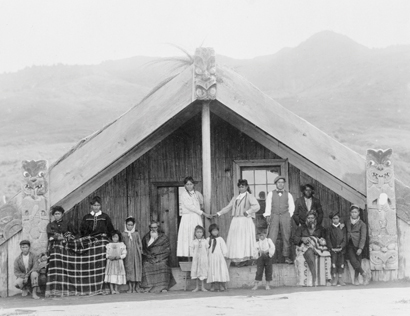 Maori people stand on the porch of a ceremonial structure, North Island, early 1900s
Maori people stand on the porch of a ceremonial structure, North Island, early 1900s
When English and Dutch settlers came to New Zealand, they built farms. Over a thousand years before, Maori people came by canoes to New Zealand. They were fishermen and bird hunters. The people in each canoe were part of a community, or pa. Each pa has one person who keeps the history of the group in his head. He tells stories in songs. This helps everyone remember the past.
Omaka is part of a Maori group. She lives with her parents and grandparents in the city on North Island. Their small house has beautiful flower gardens. Her grandparents take care of her so that her parents can work. Family life is important. Omaka speaks Maori at home and in school. She goes to school every day. She learns English with other students.
Omaka's father is a Maori artist. He carves wood and bone. Their home is filled with beautiful carvings. The local marae (mah-rah-ee), or meeting house, was decorated by Omaka's father. He carved figures of their ancestors. Her father is teaching Omaka how to carve animals and people.
Today, Omaka travels with her family to the hot springs at Rotorua. These springs are warmed by heat deep in the earth's crust. The family plans a traditional hangi. A hangi is a feast that is prepared at a hot spring. A pit is dug in the ground and filled with rocks. Meat and vegetables are placed on top of the rocks in the pit. The food is left to steam on the hot rocks for several hours. When the food is uncovered, everyone digs in and eats.
Omaka loves the hangi because so many family members are there. Everyone sings, dances, and listens to stories of people and events from long ago.
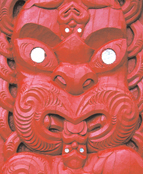 Maori carving
Maori carving
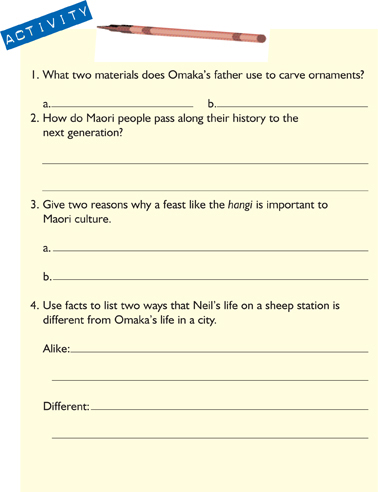
Additional topics
- Review
- How Has History Affected the People of Australia and the Pacific Region? - Who Are the People of Australia and the Pacific Region?
- Other Free Encyclopedias
History Reference: Ancient History & World HistoryThe Eastern Hemisphere - Australia and the Pacific Region





